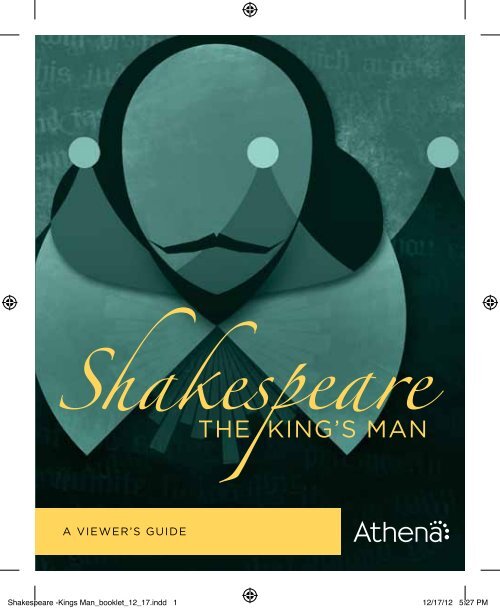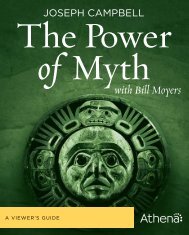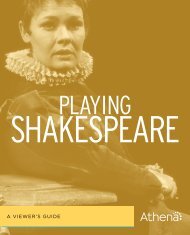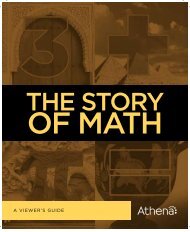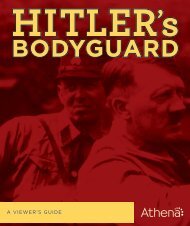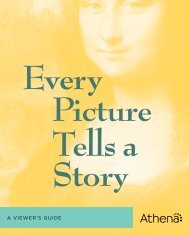Shakespeare - Athena
Shakespeare - Athena
Shakespeare - Athena
You also want an ePaper? Increase the reach of your titles
YUMPU automatically turns print PDFs into web optimized ePapers that Google loves.
<strong>Shakespeare</strong><br />
The King’s Man<br />
a viewer’s guide<br />
<strong>Shakespeare</strong> -Kings Man_booklet_12_17.indd 1<br />
12/17/12 5:27 PM
A THEATRE FOR EVERY AGE<br />
By Mark Olshaker<br />
Every age, it is said, gets the <strong>Shakespeare</strong> it deserves. As James Shapiro<br />
so eloquently points out in <strong>Shakespeare</strong>: The King’s Man, that was<br />
true even during <strong>Shakespeare</strong>’s lifetime, as his distinction between<br />
the reigns of Queen Elizabeth I and King James I demonstrate. The theatre<br />
helped Jacobean audiences of all classes interpret and make sense of the<br />
dynamic and uncertain times in which they lived, learning to navigate anew<br />
during the reign of an unpredictable Scottish king whose mother had been<br />
executed by her cousin, Queen Elizabeth, less than 20 years before.<br />
No longer would <strong>Shakespeare</strong> write the effervescent comedies of the<br />
Elizabethan years. His Jacobean comedies were dark and unsettling, dealing<br />
with such dangerous contemporary topics as betrayal, revenge, sexual<br />
exploitation, and the legitimacy of rule. Professor Shapiro tells us that an<br />
“Elizabethan <strong>Shakespeare</strong>” could not have written a tragicomedy like Measure<br />
for Measure. Like the playwright’s Jacobean tragedies, his comedies would<br />
mirror a different era, offering profound insights into the ambiguities of the<br />
human condition.<br />
Examples of theatre reflecting society and its values can be found in every<br />
age. When Oliver Cromwell’s Puritans overthrew King Charles I, they banned<br />
all plays as sordid and decadent. Following Cromwell’s death in 1658 and the<br />
restoration of the monarchy two years later under Charles II, theatres reopened<br />
and a new generation of playwrights reflected the views and energy of the<br />
day. Relieved of the yoke of the Puritan Revolution’s enforced public piety,<br />
audiences wanted to laugh. Restoration comedies such as William Wycherley’s<br />
The Country Wife and William Congreve’s The Way of the World gave them an<br />
outlet to delight in the foibles and strained manners of a high society they both<br />
envied and secretly mocked. During this more sexually open period, women’s<br />
roles were played for the first time by actual women, rather than men and boys.<br />
Subsequent decades saw the beginnings of a new type of feel-good theatre,<br />
but one that reflected a society preoccupied with making things “right” and<br />
proper. This impulse reached its preposterous nadir in 1681 with Nahum<br />
Tate’s rewriting of King Lear. Tate removed the Fool and his acerbic social<br />
commentary and substituted a new, upbeat conclusion to <strong>Shakespeare</strong>’s<br />
tragedy. In Tate’s version, Cordelia doesn’t die. Instead, she marries Edgar<br />
and they live happily ever after—a model of how audiences were expected<br />
to live their own lives.<br />
In the Victorian period, a newly industrialized and increasingly powerful<br />
Britain was displaying its prowess with stage spectacles, musical<br />
extravaganzas, and elaborate comic operas. As the 19th century progressed,<br />
Britain’s rather straight-laced society grew to favor domestic comedies and<br />
sentimental dramas with elements of realism, like Arthur Wing Pinero’s<br />
Trelawney of the “Wells.” Contrast this with the “angry young men” of<br />
London’s Royal Court Theatre in the late 1950s, where John Osborne’s Look<br />
Back in Anger stunned playgoers with its frank depiction of middle-class<br />
life and frustrations in the years following World War II.<br />
Nowhere, perhaps, does the relationship between theatre and society<br />
emerge more clearly than in comparing productions of the same<br />
<strong>Shakespeare</strong>an plays in two distinct eras. For a vivid demonstration, we can<br />
thank Laurence Olivier and Kenneth Branagh, each of whom committed<br />
memorable versions of Henry V and Hamlet to film.<br />
Olivier’s Henry V, produced during World War II as a morale booster,<br />
portrays a resolute and determined king, rallying the population in a<br />
righteous cause against a formidable enemy. The beautiful film attempts<br />
something midway between stage and screen. It begins with a staging in<br />
<strong>Shakespeare</strong>’s Globe, but when Henry’s army reaches France, the movie<br />
transports us to a semi-realistic, semi-storybook setting.<br />
Branagh’s 1989 film is a Thatcher-era, post-Falklands War meditation on<br />
1<br />
<strong>Shakespeare</strong> -Kings Man_booklet_12_17.indd 2-3<br />
12/17/12 5:27 PM
a sovereign unsure how he should lead his disillusioned nation. While<br />
Olivier’s Henry stays clean and shiny throughout the glorious Battle of<br />
Agincourt, Branagh’s king becomes a muddy, bloody mess as he fights<br />
through the rain-drenched field. Olivier’s Henry engages in heroic single<br />
combat to win the battle, while Branagh’s is almost lost in the chaos of war.<br />
Even after his victory, he is never quite sure of the morality of his actions.<br />
The two great thespians seem to reverse roles with Hamlet, yet each<br />
of their productions is decidedly a product of its time. Olivier’s Hamlet<br />
was produced in 1948, when Freudian psychoanalysis and the quest to<br />
understand human motivation were popular. Olivier presents a brooding,<br />
introspective prince set against a dark and shadowed Elsinore clinging to a<br />
bleak promontory of swirling and angry seas. He is a quiet, almost delicate<br />
Hamlet, presented as a man “who couldn’t make up his mind.” The conflict<br />
is largely internal.<br />
Branagh’s 1996 film prince has no trouble making up his mind. He is<br />
angry and decisive from the outset. We get the feeling that his problems<br />
come from other people, and he has no interest in introspection or selfanalysis.<br />
This is a strong, physical Hamlet who manhandles Ophelia and<br />
lets her father and Claudius know they cannot play him for a fool. He<br />
clearly hails from an era in which heroic males let their passions and<br />
emotions all hang out.<br />
So each age does get a bard who reflects its own needs. “Meanwhile,” as<br />
my late friend Sam Schoenbaum concluded in his masterful <strong>Shakespeare</strong>’s<br />
Lives, “<strong>Shakespeare</strong> abides.” And even in this high-tech age, the same may<br />
be said for theatre itself.<br />
Mark Olshaker is a novelist, nonfiction author, and documentary writer and producer. His film,<br />
Discovering Hamlet, with Derek Jacobi and Kenneth Branagh, is available through Acorn Media<br />
Group, an RLJ Entertainment, Inc. Company.<br />
THE ARTS OF THE JACOBEAN ERA<br />
The Elizabethan era is often referred to as England’s golden age, a<br />
time when the arts flourished. However, <strong>Shakespeare</strong> wrote some<br />
of his greatest works during the reign of James I (1603–25). Known<br />
as the Jacobean era—from Jacobus, Latin for “James”—this period offered<br />
great literary, musical, and artistic achievements of its own.<br />
James was already a king when he ascended the English throne. He had<br />
reigned as James VI of Scotland since his mother, Mary, Queen of Scots,<br />
abdicated when he was 13 months old. Regents governed for him until he<br />
became a teenager, and James had two decades of ruling experience by<br />
the time of Elizabeth’s death. Moving down to London, James discovered<br />
that his two countries had different views about kingship. In Scotland, a<br />
king was first among equals. In England, a king had vast power, position,<br />
and wealth. The English court was a place of splendor and majesty, which<br />
suited James’s extravagant tastes. When he left Scotland, he vowed to<br />
return home every couple of years. In fact, he made the journey only once.<br />
James was well-educated and refined, with his own literary ambitions. He<br />
had been tutored by the poet George Buchanan and was himself a poet.<br />
He wrote and published several books about politics and religion. He<br />
appreciated drama, although there were no public theatres in Scotland.<br />
That didn’t stop James from permitting a traveling troupe of actors to put<br />
on a play in Edinburgh in 1599, over the objections of the Scottish church.<br />
The king must have been delighted that London boasted numerous wellattended<br />
playhouses and prominent playwrights. At James’s own court, the<br />
lavish pageants known as masques approached their artistic pinnacle, with<br />
Ben Jonson providing the script and Inigo Jones the scenery.<br />
James enjoyed music too. He appointed the composer Orlando Gibbons<br />
a gentleman of the Chapel Royal, where he served as organist for many<br />
years. The famed English lutenist John Dowland returned to England after<br />
2<br />
3<br />
<strong>Shakespeare</strong> -Kings Man_booklet_12_17.indd 4-5<br />
12/17/12 5:27 PM
years abroad and became a court musician for James in 1612. James also<br />
kept a cadre of composers at court, among them Robert Johnson, Thomas<br />
Campion, and Alfonso Ferrabosco II.<br />
The king commissioned numerous new<br />
buildings and appointed Inigo Jones, a noted<br />
architect as well as a theatrical designer, as<br />
surveyor of his works. Jones had recently<br />
toured Italy, where he closely studied the<br />
works of the venerated Italian architect<br />
Palladio. Jones subsequently designed several<br />
major edifices including the Queen’s House<br />
in Greenwich, a Palladio-influenced structure<br />
The Banqueting House at<br />
Whitehall Palace<br />
now considered one of the most important buildings in the history of<br />
British architecture. He also built the magnificent Banqueting House in<br />
the Palace of Whitehall, with ceilings painted by the Flemish artist Peter<br />
Paul Rubens.<br />
© User: Thorvaldsson<br />
to Prince Henry and sergeant-painter to the<br />
king. And William Larkin earned a reputation for<br />
capturing the opulent attire worn by members of<br />
James’s court in careful detail.<br />
Today, James I is best remembered for the<br />
immense scholarly and artistic achievement<br />
that bears his name: the King James Bible. Four<br />
hundred years after it was first issued, it remains<br />
the bestselling book of all time. Commissioned by<br />
the king under pressure from the Puritans, it is<br />
Nicholas Hilliard’s selfportrait,<br />
1577<br />
a work of simplicity and majesty that permeates everyday English, much<br />
like the language of <strong>Shakespeare</strong>. “The salt of the earth,” “a labor of love,”<br />
“as old as the hills,” “the signs of the times,” “a drop in the bucket,” “skin of<br />
your teeth,” “give up the ghost,” “an eye for an eye”—these and countless<br />
other phrases come straight from the King James Bible.<br />
© The Yorck Project<br />
Like Rubens, the most prominent visual artists of the day were not English,<br />
but some native sons made their mark. Englishman Nicholas Hilliard, a<br />
renowned goldsmith and painter of miniatures, created the magnificent<br />
Lyte Jewel, a diamond-encrusted, enameled gold locket featuring a<br />
miniature portrait of the king. Robert Peake the Elder served as portraitist<br />
THE GUNPOWDER PLOT<br />
Although James I was a convinced Protestant, he was mostly<br />
tolerant regarding religion. His mother, Mary, Queen of Scots,<br />
had been a devout Catholic (which contributed to her eventual<br />
MAJOR EVENTS IN THE REIGN OF JAMES I<br />
july 25,<br />
1603<br />
1611<br />
Coronation of<br />
James brokers<br />
Death of James's<br />
March 24,<br />
James I<br />
January<br />
peace between<br />
November 5, Guy Fawkes King James Bible eldest son,<br />
june 29,<br />
1603 of England 1604 England and Spain<br />
1605<br />
executed completed Prince Henry 1613<br />
Elizabeth I dies<br />
James authorizes<br />
a new translation<br />
of the Bible<br />
1604<br />
Gunpowder Plot<br />
foiled<br />
january 31, James dissolves November 6,<br />
1606 Parliament after<br />
disagreement<br />
1612<br />
about his income<br />
The Globe theatre<br />
burns down<br />
(rebuilt a<br />
year later)<br />
4<br />
5<br />
<strong>Shakespeare</strong> -Kings Man_booklet_12_17.indd 6-7<br />
12/17/12 5:27 PM
execution). While in Scotland, James kept the peace by skillfully playing<br />
Protestant and Roman Catholic nobles against each other. He once said<br />
that he would not “persecute any [Catholics] that will be quiet and give<br />
but an outward obedience to the law, neither [would he] spare to advance<br />
any of them that will by good service worthily deserve it.”<br />
In England, James learned that some people expected him to enforce the<br />
laws against Catholics, while others hoped he would be lenient. He waived<br />
the recusancy fine—penalties charged to Catholics who refused to attend<br />
Anglican services—and included two Catholics, Henry Howard and Henry<br />
Percy, 9th Earl of Northumberland, in his Privy Council. But by 1605, after<br />
Catholic plots against his kingship and complaints that he had favored<br />
Catholics over Puritans, James expressed hostility towards Catholics.<br />
In February, he announced his “utter detestation” of Catholicism and<br />
reinstated the recusancy fines. Priests and Jesuits were expelled.<br />
Meanwhile, on May 20, 1604, Robert Catesby, a member of an English<br />
Roman Catholic family that had been persecuted by Elizabeth’s<br />
government, had met with a small group of friends including Guy Fawkes,<br />
a mercenary who had fought in the Spanish Netherlands. They hatched a<br />
plan to blow up the House of Lords, King James, and members of the royal<br />
family during the official state opening of Parliament on November 5, 1605.<br />
They rented a house in Westminster and a nearby cellar that extended<br />
George Chapman<br />
James dissolves<br />
completes<br />
Parliament a third<br />
English translation october 29, time over money march 27,<br />
1614 of Homer's works 1618 disputes 1625<br />
James dissolves<br />
Parliament again<br />
for refusing to<br />
vote him funds<br />
1616 James has Sir<br />
Walter Raleigh<br />
1621<br />
executed for<br />
treason<br />
James I dies and<br />
is succeeded by<br />
his son, Charles I<br />
beneath the House of Lords. Fawkes was<br />
charged with placing the explosives and<br />
lighting the fuse.<br />
On the evening of November 4, Fawkes was<br />
discovered guarding 36 barrels of gunpowder.<br />
An anonymous letter revealing the plot<br />
had been sent to the Catholic peer Lord<br />
Monteagle, who alerted the government.<br />
Under torture, Fawkes revealed the names<br />
Guy Fawkes Day celebrations in<br />
Lewes, England, 2009<br />
of the other conspirators. Catesby and three others were killed while<br />
resisting arrest; the rest were captured later and executed slowly and<br />
painfully on January 31, 1606. The Gunpowder Plot created a fierce new<br />
wave of anti-Catholicism and led to harsher laws. Catholics were banned<br />
from practicing law, voting in elections, and serving as military officers.<br />
Parliament made November 5 a day of public thanksgiving. Known as<br />
Guy Fawkes Day, it is still celebrated today with bonfires, fireworks, and a<br />
memorable rhyme.<br />
SOURCES FOR SHAKESPEARE’S PLAYS<br />
In the first episode of this series, host James Shapiro discusses the sources<br />
<strong>Shakespeare</strong> drew upon to write King Lear, including a prior version of<br />
the play and contemporaneous works of romantic literature, epic poetry,<br />
and religious prose. This was typical behavior—the bard consistently<br />
borrowed from old stories, legends, other writers, and histories to compose<br />
his oeuvre. In some passages, he even echoed the phrasing of his source<br />
(with modifications). As such, scholars have been able to pinpoint many of<br />
the materials <strong>Shakespeare</strong> used for his plays.<br />
For the tragedies, <strong>Shakespeare</strong> turned to classical writings and histories.<br />
He relied on Sir Thomas North’s translation of first-century Greek<br />
© Peter Trimming<br />
6<br />
7<br />
<strong>Shakespeare</strong> -Kings Man_booklet_12_17.indd 8-9<br />
12/17/12 5:27 PM
iographer Plutarch for the main plots of Timon<br />
of Athens, Coriolanus, and Antony and Cleopatra.<br />
Timon of Athens also evokes a dialogue by secondcentury<br />
Greek satirist Lucian and perhaps an<br />
anonymous play performed at the Inns of Court. In<br />
Coriolanus, the allegory of the belly and the body’s<br />
members—a metaphor for the body politic told<br />
in the first scene—features in numerous works,<br />
including Aesop’s fables. In addition to Plutarch,<br />
Antony and Cleopatra draws on histories by secondcentury<br />
Greek Appian of Alexandria. While both<br />
Greeks wrote briefly of the deserting lieutenant Enobarbus, <strong>Shakespeare</strong><br />
fleshed him out significantly. The plot for Macbeth comes from Raphael<br />
Holinshed’s 16th-century Chronicles of England, Scotlande, and Irelande.<br />
<strong>Shakespeare</strong> wisely veered from his source by absolving Banquo of the<br />
regicide, as James I was reputed to be Banquo’s descendant. Perhaps<br />
to flatter his king, <strong>Shakespeare</strong> also took elements from James’s witchhunting<br />
tract, Daemonologie, for the Weird Sisters’ scenes.<br />
The comedies also contain pilfered plots. The story of Measure for Measure<br />
had anchored several plays already; <strong>Shakespeare</strong> drew especially on works<br />
by contemporary Italian dramatist Giambattista Giraldi (byname Cinthio),<br />
as well as George Whetstone’s 1578 play Promos and Cassandra. The<br />
Winter’s Tale takes its plot from Robert<br />
Greene’s prose fiction Pandosto (1588),<br />
and the peddler and pickpocket Autolycus<br />
may have roots in pamphlets about<br />
the criminal underworld by Thomas<br />
Dekker, Thomas Harman, and Greene.<br />
For his descriptions of the hurricane and<br />
shipwreck in The Tempest, <strong>Shakespeare</strong><br />
read accounts of Virginia-bound colonists<br />
forced by storms to land on Bermuda<br />
Plutarch from a 16th c.<br />
translation of Parallel Lives<br />
Miranda – The Tempest by John William<br />
Waterhouse, 1916<br />
in 1609. French philosopher Montaigne’s essays about the New World<br />
inspired Gonzalo’s reflections on the ideal society in the second act, while<br />
Prospero’s Act 5 speech renouncing his magical powers suggests a passage<br />
from Ovid’s Metamorphoses. The Tempest, however, seems to be a rare play<br />
for which <strong>Shakespeare</strong> entirely invented his main plot.<br />
Finally, the history play Henry VIII deals with historical events taken<br />
from Holinshed’s Chronicles, along with John Foxe’s 16th-century treatise<br />
on Protestant martyrs, Actes and Monuments of these Latter and Perillous<br />
Dayes, and John Speed’s History of Great Britaine (1611).<br />
Despite employing these and many other elements in his work,<br />
<strong>Shakespeare</strong> did not simply imitate those who came before him. He<br />
molded the material to his will, inventing new characters and developing<br />
fully formed ones based on mere mentions in his predecessors’ work. He<br />
reordered plot lines to intensify contrasts and bring out themes, deleted<br />
and added material to enhance drama, and beautified the language. He<br />
occasionally collaborated with other playwrights—all while still imprinting<br />
his unique voice to the result. <strong>Shakespeare</strong>’s magpie-like acquisition<br />
of outside material was not an unusual practice for the period, but his<br />
dramatic talents proved to be, as Ben Jonson proclaimed, “not of an age, but<br />
for all time.”<br />
Booklet written and edited by Pamela Espeland, Elizabeth Stocum, and Jennifer Coggins. © 2012 Acorn Media<br />
Group Inc. Some images licensed under Wikimedia Commons CC BY-SA 2.0 and 3.0.<br />
Visit our website for discussion questions and more<br />
information on the full line of <strong>Athena</strong> programming.<br />
athenalearning.com<br />
8<br />
9<br />
<strong>Shakespeare</strong> -Kings Man_booklet_12_17.indd 10-11<br />
12/17/12 5:27 PM
JOIN THE<br />
DISCUSSION!<br />
We want you to be a part of our fun<br />
ONLINE COMMUNITY. Get to know us,<br />
explore more <strong>Athena</strong> topics, and even<br />
win free stuff!<br />
VISIT <strong>Athena</strong>Learning.com to watch<br />
videos from all our <strong>Athena</strong> documentaries<br />
and delve deeper into the subjects that<br />
interest you<br />
FOLLOW us on Twitter<br />
(@<strong>Athena</strong>Docs) for contests,<br />
product announcements, and relevant<br />
news<br />
LIKE us on Facebook<br />
(<strong>Athena</strong>Documentaries) to chat with other<br />
documentary fans, enter to win free DVDs,<br />
and check out exclusive video clips<br />
Also on DVD<br />
<strong>Shakespeare</strong> -Kings Man_booklet_12_17.indd 12<br />
12/17/12 5:27 PM


